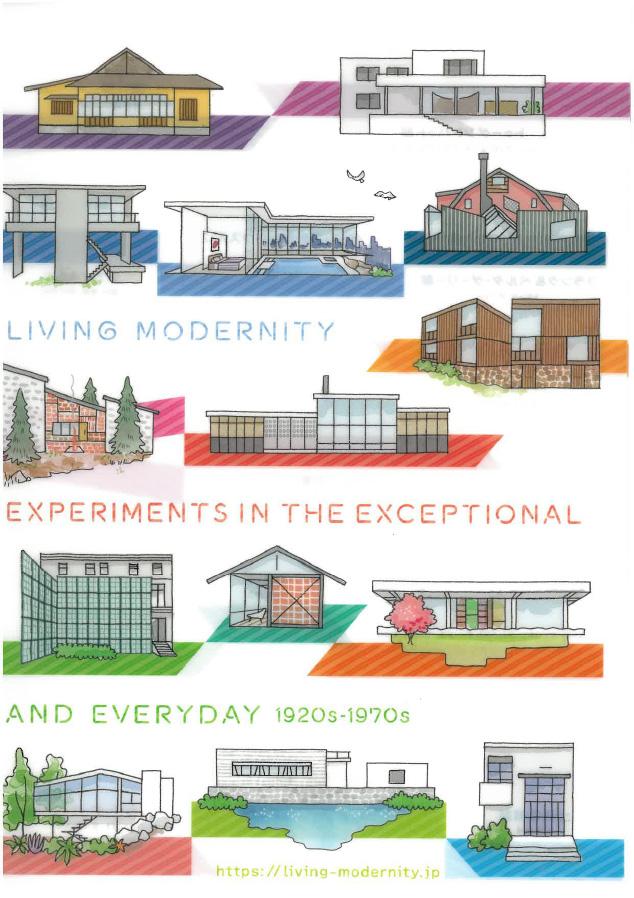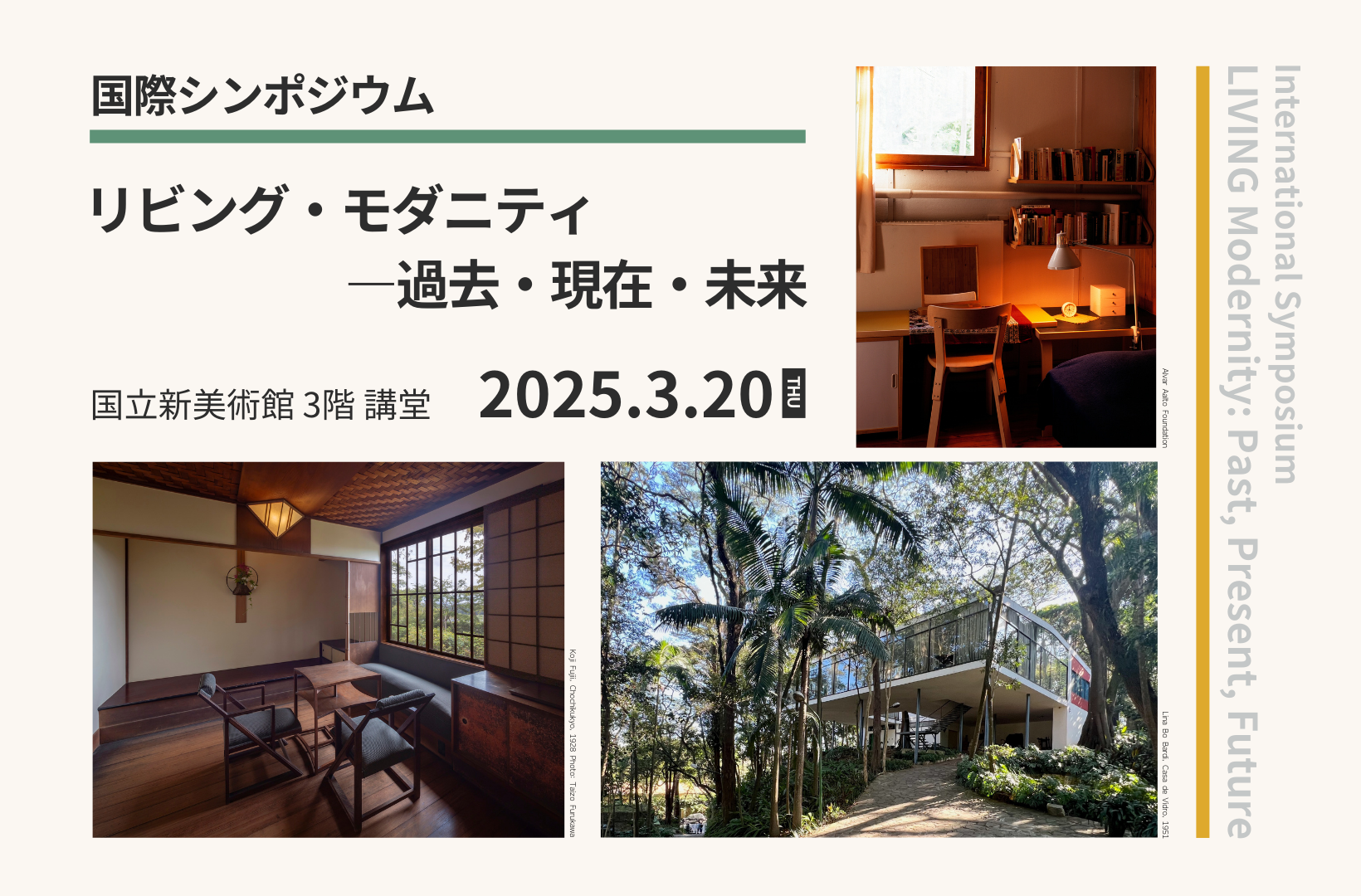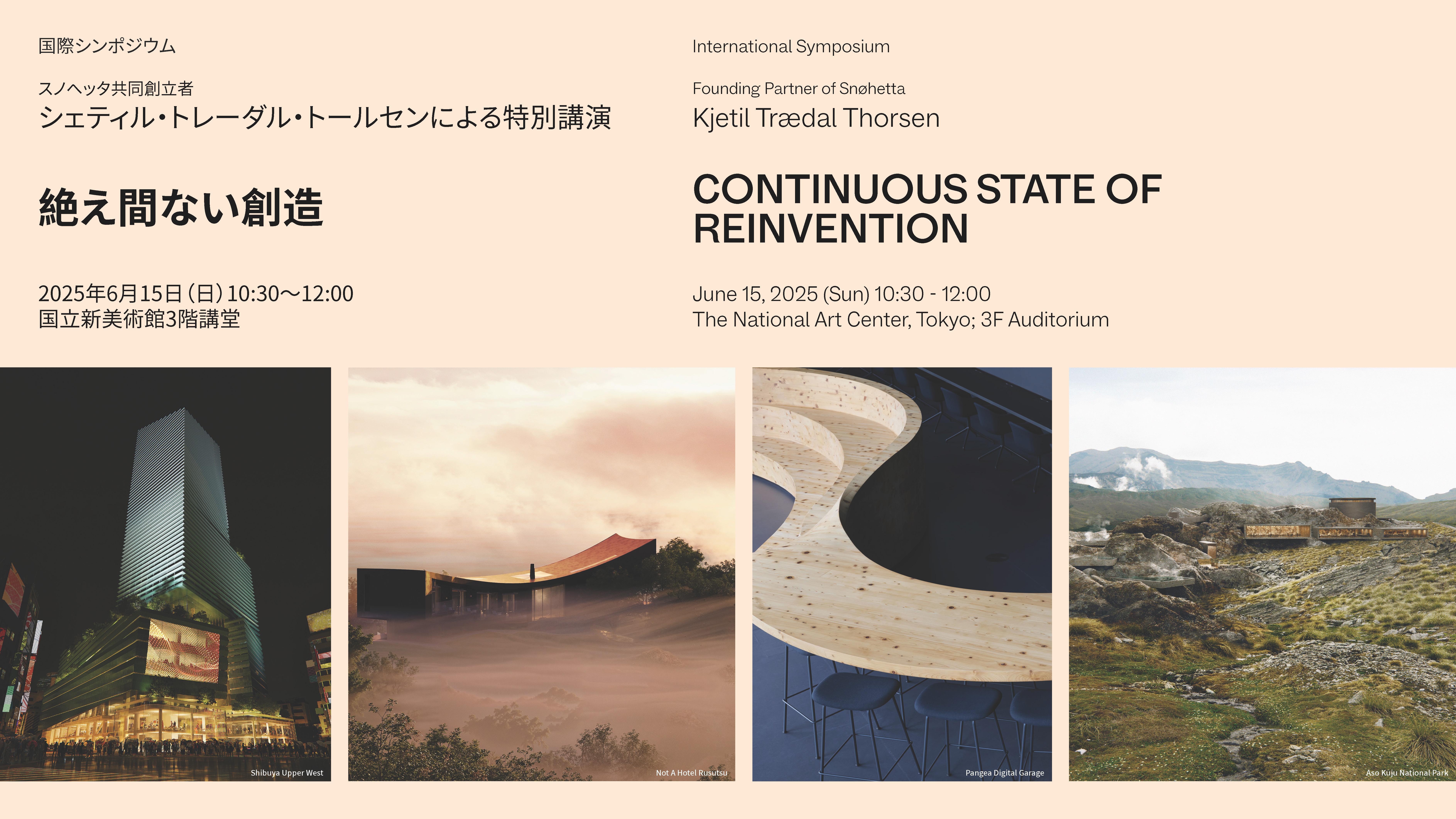LIVING Modernity: Experiments in the Exceptional and Everyday 1920s-1970s
March 19 (Wed), 2025 - June 30 (Mon), 2025
- Past Exhibitions
- Special Exhibitions
From the 1920s, architects such as Le Corbusier (1887-1965) and Ludwig Mies van der Rohe(1886-1969) have sought to create both functional and comfortable living spaces, employingnew technologies constantly developing through time. Their exemplary experimentalvisions and innovative ideas eventually spread broadly to drastically transform people'sdaily lives.
This exhibition showcases houses designed by architects who embraced modernity byreexamining the fundamentals of living to improve functionality, artistry and comfort. Builtduring the epic modern period of the 1920s to the 1970s, these houses share theinternational ethos of creating a new architecture fundamentally connected to their specifictime, region, climate, and social context. They also vividly express the family dynamics andcharacters of their individual residents. Innovations in living by the architects pursuing ideallifestyles are deeply intertwined with the distinct context of each house.
These houses were also a means to solve universal issues that have emerged in moderntimes. Sanitary spaces that promote personal hygiene, expansive glass windows to bring inlight and breezes, kitchens to reduce household chores, furnishings such as chairs andlighting to enhance bodily comfort, and verdant landscapes brought into living spacesbecame key elements in defining residential architecture in the 20th century. Iconic imagesof these new living spaces proliferated widely through model home exhibitions, magazinesand other new media.
This exhibition reexamines these innovative aspirations in residential architecture thatemerged in the 20th century from seven perspectives that define modern houses: hygiene,materiality, windows, kitchen, furnishings, media, and landscape. Highlighting 14residential masterpieces, the exhibition provides a multi-faceted examination of 20thcentury experimental homes through photographs, drawings and sketches, models,furnishings, textiles, tableware, and magazines and graphics.
LIVING Modernity, which began as an experimental endeavor 100 years ago, has come topermeate our daily lives and continues to evolve to this day. This exhibition offers anopportunity to reconsider how we live today.
Overview
- Period
-
March 19 (Wed), 2025 – June 30 (Mon), 2025
Closed on Tuesdays, May7
(Open on April 29, May 6) - Opening Hours
10:00-18:00
(Fridays and Saturdays, 10:00-20:00)
(Last admission 30 minutes before closing)- Venue
-
The National Art Center, Tokyo
Special Exhibition Gallery 1E, 2E
7-22-2 Roppongi, Minato-ku, Tokyo 106-8558 - Organized by
The National Art Center, Tokyo; The Tokyo Shimbun; Japan Arts Council; Agency for Cultural Affairs, Government of Japan

With the support of
Architectural Institute of Japan / The Japan Institute of ArchitectsWith the sponsorship of
KAJIMA CORPORATION / TOTO LTD. / HASEKO Corporation / YKK AP Inc. /
Sekisui House, Ltd. / Daiwa House Industry Co., Ltd. / Fujiki Komuten Co.,Ltd.With the cooperation of
MISAWA HOMES CO., LTD. / TAKENAKA CORPORATION / Shinkenchiku-sha Co., Ltd. / arc co., ltd. /
USHIO LIGHTING, INC.- Admission (tax included)
-
1,800 yen (Adults), 1,000 yen (College students), 500yen (High school students)
*Visitors who are junior high school students or younger will be admitted for free.
*Disabled persons (along with the one assistant) will be admitted for free upon presenting the Disabled Person’s Booklet or an equivalent form of government-issued ID.
A part of exhibition area can be viewed admission free. - Touring Information
The Hyogo Prefectural Museum of Art
September 20 (Sat.), 2025 – January 4 (Sun.), 2026 (TBC)- Inquiries
(+81) 47-316-2772 (Hello Dial)
Exhibition Themes
The house: an exhibition emerging from our everyday lives
A house consisting of a living room and kitchen at the center of the floor plan, equipped withcomfortable sanitary facilities and separate rooms for family members may seem to becommon today. Historically, this is a relatively new type of housing that gained popularityalong with the nuclear family becoming the norm after World War II. Single family housesspreading widely in the 20th century shaped a variety of lifestyles, strongly reflecting theideals of the residents. This exhibition revisits the pillars of our everyday life through 14exceptional residential projects, shedding light on the 1920s to 1970s when innovativehousing design spread across the globe.
|
Frank Gehry, |
Master architects’ passion towards the home
The houses showcased in this exhibition are by renowned architects who designed on bothlarge and human scales. As leading architects of the era, they had a deep interest in everydaylife at the heart of their creativity. Many of the featured projects are the architects'residences, serving as the ideal space for experimenting with new architectural concepts.From their meticulous attention to even the smallest details, we catch glimpses of theirpursuit of functionality and comfort as well as their genuine appreciation for the joy anddelight of living.
|
Kameki Tsuchiura, |
A rich assemblage of works and images from Japan and the world
This exhibition brings together a rare and exceptional collection of works spanning the globe,including the United States, Europe, Brazil, and Japan. The exhibition features original, rarelyexhibited drawings by the architects such as Mies van der Rohe and Alvar Aalto in addition toarchitectural drawings, models and photographs of both exteriors and interiors. Furnitureand household items designed for their residential projects, along with films, will also be ondisplay. The exhibition offers a comprehensive reexamination of re through these diverseworks and images.
|
Lina Bo Bardi, Casa de Vidro, 1951 |
A centenary of modern houses + iconic furniture and lighting still in use today
The housing designs featured in this exhibition, along with the chairs, tables, and lightingdesigned by the architects to complement these homes, remain strikingly “modern” even bytoday's standards. Many of these pieces of furniture and fixtures are still in production anduse today. Behind these masterworks, which we often encounter in our daily lives, lie thetimeless, universal questions that architects and designers have posed about function andform.
|
Otto Lindig, Cocoa Pot, 1923, |
Marcel Breuer, Side Chair B32, 1928, |
Realizing a Mies van der Rohe unbuilt courtyard house at full scale
Following the exhibition in Special Exhibition Gallery 1E on the first floor, the 8-meter-highSpecial Exhibition Gallery 2E on the second floor will feature a full-scale reproduction of Mies van der Rohe's “Row House” project (1931) as part of his ongoing courtyard house series.Visitors will also be able to explore an immersive experience showcasing iconiccontemporaneous furniture, along with a virtual reality experiential installation. Additionally,we will hold lectures and more events in the second-floor gallery. The second floor, includingthe opportunity to experience Row House , will be free and open to all visitors.
Exhibition Layout
This exhibition considers seven fundamental challenges faced by architects in the 20thcentury, focusing on 14 residential masterworks spanning the globe.
14 residential masterpieces
HYGIENE: creating a culture of cleanliness
As underscored by the 2020 COVID-19 pandemic, maintaining health and hygiene inconfronting infectious diseases has long been one of humanity's most critical challenges.Architects in the early part of the 20th century sought to maximize natural light andventilation to combat tuberculosis in an age of rapid urbanization and increased populationdensity. As a starting point for modern design, the bathroom and requisite fixtures becameparticularly important to promote hygiene and well-being through cleanliness of the body.
|
Alvar Aalto, Murtala Experimental House, 1952 |
MATERIALITY: discovering physical functions
In the 20th century, steel, concrete and mass-produced glass transformed the house,affording a new sense of lightness and spatial freedom. Architects embraced these materialchanges and rediscovered the potential of traditional materials including wood, tiles, andtextiles. This exhibition highlights the ways they domesticated these materials for modernliving.
|
Pierre Chareau, Maison de Verre, 1932 |
WINDOW: framing indoor/outdoor living
Advancements in reinforced concrete construction and production of glass brought on newpossibilities to liberate the wall for window openings. Unprecedented large windowsafforded natural light and ventilation, as well as panoramic views from inside the home. Thetransformation of the window fundamentally redefined the boundary between interior andexterior, creating seamless connections between indoor and outdoor living spaces.
|
Louis Kahn, Fisher House, 1967 |
KITCHEN: modernizing the hearth
Modern kitchens followed developments brought on by industrialrevolution. The Frankfurt Kitchen (1926) emerged based on theethos of maximizing efficiency of space and movement in cooking a ta minimal cost for some 10,000 social housing units in Frankfurt andhas had global influence in the development of built-in andsystematized kitchens. Cooking spaces traditionally placed at theback of the house, such a s in European basements or Japanese doma(dirt floor), shifted to brighter, more central locations near diningand living a reas and reflected the increasing prominence of thenuclear family and liberation afforded by modern appliances.
|
Frank Gehry, |
FURNISHINGS: creating comfortable living
A range of design movements emerged in the 19th century inreaction against the indiscriminate replication of past styles and theoverwhelming presence of low-quality mass-produced items. In the20th century, such modern movements could be found in theBauhaus (1919-1933) to combine crafts and fine arts while seekingto unify individual artistic vision with industrial production.Designers at the Bauhaus realized these ideals through the creationof everyday items such as textiles, metalware, lighting, andfurniture. Many of the architects who sought to harmonizefurnishings together with their architectural designs alsothemselves designed furniture and other household items. Thisexhibition showcases various furnishings that enriched everyday lifein the 20th century from the Bauhaus and beyond based on their new aesthetic sensitivities.
|
Eero Saarinen, Alexander Girard, Dan Kiley, Miller House, 1957 |
MEDIA: visualizing the dwelling
Advancements in photography and modern printing technology in the 20th centuryafforded the development of mass media platforms of newspapers and magazines thatwould circulate worldwide. Architects and designers from Le Corbusier to Kōji Fujii,embraced these new media to present their design ideas to the broader public audience.Housing exhibitions such as the Deutscher Werkbund exhibition in 1927, Die Wohnung (TheDwelling). promoted the modern house through direct experience. This section examinesthe broad range of media from books and magazines to housing exhibitions to promoteideal lifestyles to the public at large.
|
Koji Fujii, Chochikukyo, 1928 |
LANDSCAPE: living in nature
How can one live in harmony with the natural environment and specificities of sight withinmanmade spaces for living? This became a vital challenge for modern houses in the 20thcentury. Expansive glass windows afford the primary experience of changes through thefour seasons and natural flora and fauna. Beyond the physicality of the window, theseconnections to the elements of light and air extend to promoting hygiene and health torestore fundamental bonds with nature suppressed through rapid modernization tocontribute to one's overall well-being. How do we situate living spaces in the naturalenvironment in harmony with the site character of the land? This exhibition therebyconsiders such efforts to fundamentally sustain the home in harmony with natural forces.
|
Lina Bo Bardi, Casa de Vidro, 1951 |
LIVING Modernity today
Exhibitors
B&B Italia
Carl Hansen & Søn
Cassina
Karimoku Case
Marcenaria Baraúna
Molteni&C
TECTA
Knoll
YAMAGIWA
Giveaway for weekdays only(an original exhibition clear file)

5/21 (Wed) to 6/20 (Fri) on weekdays only, the first 100 visitors will receive an original exhibition clear file with illustrations of the 14 architectural works featured in the exhibition.
We look forward to your visit.
Distribution period: Weekdays from May 21 (Wed) to June 20 (Fri), 2025
Distribution location:Special Exhibition Gallery 1E
*One copy per person will be given out at the entrance to the exhibition.
*The giveaway is limited.
Guidebook
Related books
A list of materials related to the exhibition that were introduced in the Art Library are available on the OPAC. Please click here to see the list on Past Special Book Exhibit page.
These materials are also available in the Art Library on the 3rd floor. Please click here to see the Art Library's general information.



